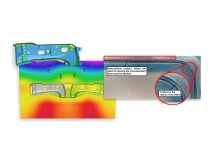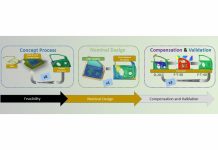Customer Whiston Industries Shares Insights
on Using AutoForm for Large Panels
[dropcap]R[/dropcap]ecently Whiston Industries invited AutoForm to view their tool making plant to see our software in action. AutoForm’s own Dave Ling, Senior Technical Consultant, AutoForm UK joined us to shed more light on this success, with many customers taking a keen interest in the ‘One Time Tryout’ which is becoming a byword after its success in Japan.
Whiston Industries is a well-known tool manufacturer in the UK, providing press tools to not only the automotive industry but also to aerospace, medical, energy and marine industries. Producing transfer dies, progressive dies, and stamping tools, they make use of AutoForm for its tool making and die design projects.
‘Whiston is a positive customer to work with’ says David Ling, Senior Technical Consultant form AutoForm UK. ‘They specialize in larger dies for larger panels like skin panels, tail gate inners and outers. I’ve personally worked with Whiston for more than twenty years in three different roles. First as a customer when I worked for Rover, as we bought dies from them. Then during my time at ESI I worked supplying their solutions. After I joined AutoForm our relationship grew when they joined AutoForm as well.’
David adds ‘From our perspective for what we have tried to achieve is help Whiston arrive to a point where simulation really drives their process. It’s amazing to see so much success when they have just two specialists in-house who deal with simulation. They don’t want drawn out implementation. This is a company that gets things done. They have worked to get the best out of the software and are very self-sufficient.’
For the automotive industry Whiston provides body in white components, including major structural, chassis and class-A skin panels. In doing so they utilize high strength steels (HSS) and aluminum components, producing approximately eighty dies per year.
No stranger to big business their OEM customers include Jaguar Land Rover, VW, Rolls Royce, MG Rover, Audi, Ford Trucks, BMW and Mercedes.

Steve Hackett, Engineering and Technical Consultant at Whiston said ‘We use AutoForm software on every single project we do from conception (feasibility data, using DieDesigner for blank-holder and addendum shape) to inspection of the die. What you run in your simulation must mimic, as closely as possible, what you are going to manufacture. That way, you get correlation…. and there must always be correlation. The output we see on AutoForm software (the digital master) must match what we see in reality.’
Dave talks about visiting Whiston’s plant, saying ‘They rarely call for on-hand assistance to look at the simulations they’ve run and during those few occasions I saw that they had done everything right. In fact when they machine the dies they come out perfectly. Whiston is achieving what the Japanese call the ‘One Time Tryout.’ In the last project I personally witnessed a heroic achievement. Of the nine dies they had made eight of those went through tryout with zero recuts, specifically for aluminum parts. And we are not talking about dies here for any small measure like making a bracket to mount a radio inside a vehicle. We are talking about big dies for body sized fenders, and for roofs and doors from aluminum. Of course there is the die finishing stage. But they are not re-machining. They polish and maybe adjust drawbeads for example. But to not have to re-machine the dies is what makes it so impressive.’

Steve Hackett explains their approach, ‘We always model the tooling surfaces exactly as the die was simulated. This also increases die quality and saves us money, as we rarely have to recut draw dies. You need to minimize springback as well as consider what the follow-on dies will do after the first forming operation i.e. how that part is going to sit on those dies. So, when you make a drawn shell (before the sheet is trimmed and becomes a finished part), we need to decide whether we will compensate for our first trim at the digital AutoForm model (which we do in many cases, if the springback is low). If there is a lot of springback, we may need to think about making drawn shells and scanning the part. The die manufacture must be of high enough quality to duplicate this performance across several dies. We are really happy with AutoForm software – we use their DieDesigner, Trim and Sigma modules. We are also looking at using its hemming software in future.”
In accordance with the increasing trend towards vehicle lightweighting, Steve has noticed more aluminum creeping into die design. Around 70% of the parts he sees now are made from aluminum which, he says, also displays greater springback than steel.
“Toolmaking is constant problem-solving. Everything is made to order, a one-off. The forming software is the virtual tryout. We apply the 1/10/100 rule in toolmaking; it costs you £1 in simulation, £10 in design and £100 when the die is finished,” he told ISMR.
Mr. Hackett also gave a nice example of AutoForm in use, saying ‘The new Aston Martin Vantage has just been released, and Whiston Industries is manufacturing dies for the doors, bonnet (aluminum), roof and body side (steel) of this new model. The body side was a real challenge… the shape is very deep. But AutoForm simulation software has helped to produce the die for this, a testament to the size and complexity of the skin panels.”
Dave finished with ‘Currently Whiston Industries uses AutoForm-Diedesigner, AutoForm-Incremental, AutoForm-Sigma and AutoForm-Compensatorplus. Now we are working with them to implement TryoutAssistant, ProcessDesignerforCATIA and HemPlanner to continue our on-going collaboration.’














